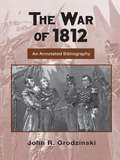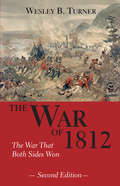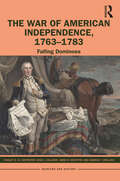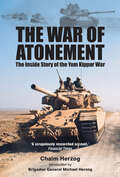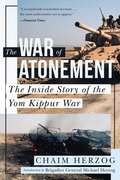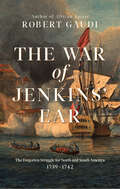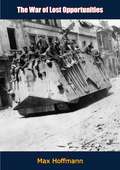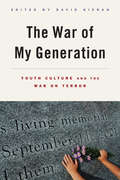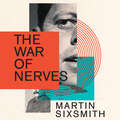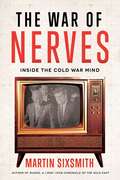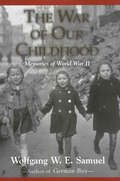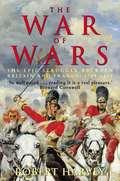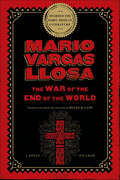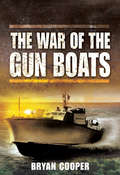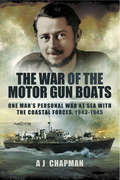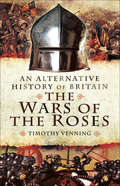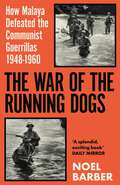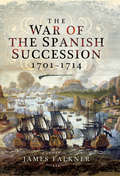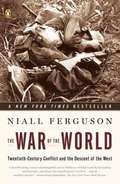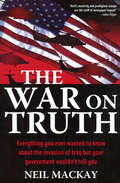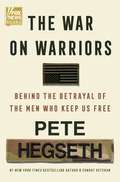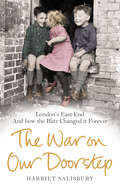- Table View
- List View
The War of 1812: An Annotated Bibliography (Routledge Research Guides to American Military Studies)
by John GrodzinskiJohn R. Grodzinski’s volume in the Routledge Research Guides to American Military Studies covers the origins of the War of 1812 - the major post-revolutionary conflict fought between the United States and the British Empire - providing a general overview of the significant battles that occurred at sea and in the area of the present-day Great Lakes and U.S.-Canadian border. The key features of this research guide are the bibliographical elements, namely lists of published books, articles, and on-line resources pertaining to the War of 1812, as well as references to archival resources available in the United States, United Kingdom, and Canada. The War of 1812 is a valuable supplementary resource for institutional libraries on both sides of the Atlantic.
The War of 1812: The War That Both Sides Won
by Wesley B. TurnerTragedy and farce, bravery and cowardice, intelligence and foolishness, sense and nonsense - all these contradictions and more have characterized the War of 1812. The real significance of the series of skirmishes that collectively made up the war between 1812 and 1814 is the enormous impact they have had on Canadian and American views of themselves and of each other. The publication of The War of 1812: The War That Both Sides Won in 1990 provided a contemporary look at the period, and included such developments as the 1975 discovery of the Hamilton and Scourge on the bottom of Lake Ontario, and the 1987 discovery of the skeletons of casualties at Snake Hill. Now, a decade later, Wesley B. Turner has updated The War of 1812 to include the volumes of new research that have come to light in recent years. All this new material has been incorporated into this interesting and informative overview of a crucial period in Canada’s history.
The War of American Independence, 1763-1783: Falling Dominoes (Warfare and History)
by Stanley D. Carpenter Kevin J. Delamer James R. McIntyre Andrew T. ZwillingThe War of American Independence, 1763–1783: Falling Dominoes addresses the military, maritime and naval, economic, key personalities, key societal groups, political, imperial rivalry, and diplomatic dynamics and events from the post-Seven Years’ War era in Great Britain’s North American colonies through the end of the War of American Independence. Beginning in 1763 and moving through the war chronologically, the authors argue that British political and strategic leaders failed to develop an effective strategy to quell the discontent and subsequent revolt in the North American colonies and thus failed to restore allegiance to the Crown. This book describes and analyzes events and the outcomes of central players’ decisions—the British North American colonies, Great Britain, France, Spain, and the Dutch Republic—and the resultant actions. It examines events through the thematic lens of strategy, political and military leadership, public attitudes, economics, international rivalries and relations, and the role of traditionally less-considered groups: women, slaves, and Native American peoples. This book is an enlightening and essential read for all history students, from high school through to those on postgraduate courses, as well as those with an interest in the American Revolution.
The War of Atonement: The Inside Story of the Yom Kippur War
by Chaim HerzogAn authoritative account of the Israeli army’s performance in the bitter Yom Kippur War of 1973.In The War of Atonement, the origins of the Yom Kippur War amid the turbulent history of competing powers in the Middle East are fully explored, as is the build-up of Arab forces that almost inexplicably caught Israel by surprise. The author then provides a gripping narrative of the conflict itself, punctuated by firsthand accounts and interviews with combatants. The War of Atonement is full of drama and tales of inspirational bravery, as Israel defied the odds to defeat the two-pronged invasion. An analysis of the political implications of the conflict bring this epic tale to a close.For this edition Chaim Herzog’s son, Brigadier General Michael Herzog, has written an introduction which places the book in the context of his father’s achievements and gives a revealing insight into the man himself. This is the most comprehensive work on a conflict that has had major implications for our own troubled times.“Certainly the best account of the war from the Israeli standpoint that has yet appeared or is likely to appear for some years to come.” —The New York Times Book Review“A scrupulously researched account . . . the most authoritative yet to appear.” —Financial Times“Herzog’s volume is still very much a required classic on the subject. Clearly and concisely written, there is much to learn from this book.” —Air and Space Magazine“One of the best accounts of the Yom Kippur War . . . In addition to providing a detailed account of each of the major battles as well as useful general information on the political leaders and generals of both sides, the author recounts in detail the heroism of individual Israeli Army units that were greatly outnumbered.” —Jewish Book World
The War of Atonement: The Inside Story of the Yom Kippur War (Greenhill Military Paperback Ser.)
by Chaim Herzog Brigadier General Michael HerzogThis is the authoritative account of the Israeli army’s performance in the bitter Yom Kippur War of 1973. The origins of the war amid the turbulent history of competing powers in the Middle East are fully explored, as is the build-up of Arab forces that almost inexplicably caught Israel by surprise. The author then provides a gripping narrative of the conflict itself, punctuated by firsthand accounts and interviews with combatants. The War of Atonement is full of drama and tales of inspirational bravery, as Israel defied the odds to defeat the two-pronged invasion. An analysis of the political implications of the conflict bring this epic tale to a close. For this edition Chaim Herzog’s son, Brigadier General Michael Herzog, has written an introduction which places the book in the context of his father’s achievements and gives a revealing insight into the man himself. This is the most comprehensive work on a conflict that has had major implications for our own troubled times.
The War of Jenkins' Ear: The Forgotten Struggle for North and South America: 1739-1742
by Robert GaudiFilled with unforgettable characters and martime adventure, the incredible story of a forgotten war that shaped the fate of the United States—and the entire Western Hemisphere.In the early 18th century, the British and Spanish Empires were fighting for economic supremacy in the Americas. Tensions between the two powers were high, and wars blossomed like violent flowers for nearly a hundred years, from the War of Spanish Succession (sometimes known as Queen Anne's War in the Americas), culminating in the War of Jenkins' Ear. This war would lay the ground work for the French and Indian War and, eventually, the War of the American Revolution. The War of Jenkins' Ear was a world war in the truest sense, engaging the major European powers on battlefields ranging from Europe to the Americas to the Asian subcontinent. Yet the conflict that would eventually become known as the War of Jenkins' Ear—a moniker coined by the 19th century historian Robert Carlyle more than a century later—is barely known to us today. Yet it resulted in the invasion of Georgia and even involved members of George Washington&’s own family. It would cost fifty-thousand lives, millions in treasure, and over six hundred ships. With vivid prose, Robert Gaudi takes the reader from the brackish waters of the Chesapeake Bay to the rocky shores of Tierra del Fuego. We travel around the Cape of Good Hope and across the Pacific to the Philippines and the Cantonese coast, with stops in Cartagena, Panama, and beyond. Yet even though it happened decades before American independence, The War of Jenkins' Ear reveals that this was truly an American war; a hard-fought, costly struggle that determined the fate of the Americas, and in which, for the first time, American armies participated. In this definitive work of history—the only single comprehensive volume on the subject—The War of Jenkins&’ Ear explores the war that establed the future of two entire continents.
The War of Lost Opportunities (Great War Ser. #Vol. 75)
by Max HoffmannFirst published in 1924, German General Max Hoffmann’s The War of Lost Opportunities examines missed opportunities for the German military during the First World War.The book takes particular note of The Battle of Tannenberg fought between August 26-30, 1914, which resulted in the almost complete destruction of the Russian Second Army and the suicide of its commanding general, Alexander Samsonov.The battle also led to the 1918 Spring Offensive—otherwise known as Kaiserschlacht (“Kaiser’s Battle”), or the Ludendorff Offensive—which saw a series of German attacks along the Western Front, beginning on 21 March 1918, that marked the deepest advances by either side since 1914.An invaluable addition to any First World War book collection.
The War of My Generation: Youth Culture and the War on Terror
by Cindy Dell Clark Laura Browder David Kieran Irene Garza Rebecca A. Adelman Benjamin Cooper Jo Lampert Robertson Allen Jeremy K. Saucier Holly Swyers Professor Sunaina MairaFollowing the 9/11 attacks, approximately four million Americans have turned eighteen each year and more than fifty million children have been born. These members of the millennial and post-millennial generation have come of age in a moment marked by increased anxiety about terrorism, two protracted wars, and policies that have raised questions about the United States's role abroad and at home. Young people have not been shielded from the attacks or from the wars and policy debates that followed. Instead, they have been active participants--as potential military recruits and organizers for social justice amid anti-immigration policies, as students in schools learning about the attacks or readers of young adult literature about wars. The War of My Generation is the first essay collection to focus specifically on how the terrorist attacks and their aftermath have shaped these new generations of Americans. Drawing from a variety of disciplines, including anthropology, sociology, cultural studies, and literary studies, the essays cover a wide range of topics, from graphic war images in the classroom to computer games designed to promote military recruitment to emails from parents in the combat zone. The collection considers what cultural factors and products have shaped young people's experience of the 9/11 attacks, the wars that have followed, and their experiences as emerging citizen-subjects in that moment. Revealing how young people understand the War on Terror--and how adults understand the way young people think--The War of My Generation offers groundbreaking research on catastrophic events still fresh in our minds.
The War of Nerves: Inside the Cold War Mind
by Martin SixsmithMore than any other conflict, the Cold War was fought on the battlefield of the human mind. And, nearly thirty years since the collapse of the Soviet Union, its legacy still endures - not only in our politics, but in our own thoughts, and fears.Drawing on a vast array of untapped archives and unseen sources, Martin Sixsmith vividly recreates the tensions and paranoia of the Cold War, framing it for the first time from a psychological perspective. Revisiting towering personalities like Khrushchev, Kennedy and Nixon, as well as the lives of the unknown millions who were caught up in the conflict, this is a gripping account of fear itself - and in today's uncertain times, it is more resonant than ever.
The War of Nerves: Inside the Cold War Mind
by Martin SixsmithA major new history of the Cold War that explores the conflict through the minds of the people who lived through it.More than any other conflict, the Cold War was fought on the battlefield of the human mind. And, nearly thirty years since the collapse of the Soviet Union, its legacy still endures—not only in our politics, but in our own thoughts and fears. Drawing on a vast array of untapped archives and unseen sources, Martin Sixsmith vividly recreates the tensions and paranoia of the Cold War, framing it for the first time from a psychological perspective. Revisiting towering, unique personalities like Khrushchev, Kennedy, and Nixon, as well as the lives of the unknown millions who were caught up in the conflict, this is a gripping narrative of the paranoia of the Cold War—and in today's uncertain times, this story is more resonant than ever.
The War of Our Childhood: Memories of World War II
by Colonel Wolfgang W. SamuelOne survivor tells of the fire-bombing of Dresden. Another survivor recounts the pervasive fear of marauding Russian and Czech bandits raping and killing. Children recall fathers who were only photographs and mothers who were saviors and heroes. These are typical in the stories collected in The War of Our Childhood: Memories of World War II. For this book Wolfgang W. E. Samuel, a childhood refugee himself after the fall of Nazi Germany, interviewed twenty-seven men and women who as children—by chance and sheer resilience—survived Allied bombs, invading armies, hunger, and chaos. “Our eyes carried no hate, only recognition of what was,” Samuel writes of his childhood. “Peace was an abstraction. The world we Kinder knew nearly always had the word ‘war’ appended to it.” Samuel's heartfelt narratives from these innocent survivors are invariably riveting and often terrifying. Each engrossing story has perilous and tragic moments—school children in Leuna who are sent home during an air raid but are strafed as moving targets; fathers who exist only as distant figures, returning to their families long after the war—or not at all; mothers who are raped and tortured; families who are forced into a seemingly endless relocation that replicates the terrors of war itself. In capturing such experiences from nearly every region of Germany and involving people of every socio-economic class, this is a collection of unique memories, but each account contributes to a cumulative understanding of the war that is more personal than strategic surveys and histories. For Samuel and the survivors he interviewed, agony and fright were part of everyday life, just as were play, wondrous experience, and above all perseverance. “My focus,” Samuel writes, “is on the astounding ability of a generation of German children to emerge from debilitating circumstances as sane and productive human beings.”
The War of Wars: The Epic Struggle Between Britain And France, 1789-1815 (Social And Economic Studies Of Post-war France Ser.)
by Robert HarveyRobert Harvey brilliantly recreates the story of the greatest conflict that stretches from the first blaze of revolution in Paris in 1789 to final victory on the muddy fields of Waterloo.On land and at sea, throughout the four corners of the continent, from the frozen plains surrounding Moscow and terror on the Caribbean seas, to the muddy low lands of Flanders and the becalmed waters of Trafalgar, The War of Wars tells the powerful story of the greatest conflict of the age.
The War of Wars: The Epic Struggle Between Britain and France: 1789-1815 (Social And Economic Studies Of Post-war France Ser.)
by Robert HarveyRobert Harvey brilliantly recreates the story of the greatest conflict that stretches from the first blaze of revolution in Paris in 1789 to final victory on the muddy fields of Waterloo.On land and at sea, throughout the four corners of the continent, from the frozen plains surrounding Moscow and terror on the Caribbean seas, to the muddy low lands of Flanders and the becalmed waters of Trafalgar, The War of Wars tells the powerful story of the greatest conflict of the age.
The War of the End of the World: A Novel
by Mario Vargas LlosaThe Nobel Prize–winning author’s classic novel of civil war in nineteenth-century Brazil: “A modern tragedy on the grand scale . . . As dark as spilled blood” (Salman Rushdie, The New Republic).Deep within the remote backlands of Brazil lies Canudos, home to all the damned of the earth: prostitutes, bandits, beggars, and every kind of outcast. It is a place where history and civilization have been wiped away. There is no money, no taxation, no marriage, no census. Canudos is a cauldron for the revolutionary spirit in its purest form, a state with all the potential for a true, libertarian paradise—and one the Brazilian government is determined to crush at any cost.In perhaps his most ambitious and tragic novel, Mario Vargas Llosa offers his fictionalized vision of the story of Canudos, inhabiting characters on both sides of the massive, cataclysmic battle between the society and government troops. The resulting novel is a fable of Latin American revolutionary history, an unforgettable story of passion, violence, and the devastation that follows from fanaticism.
The War of the Gun Boats
by Bryan CooperThe 'little ships' of the Second World War - the fast and highly maneuverable motor torpedo boats and gunboats which fought in coastal waters all over the world - developed a special kind of naval warfare. With their daring nightly raids against an enemy's coastal shipping - and sometimes much larger warships - they acquired the buccaneering spirit of an earlier age. And never more so than in the close hand-to-hand battles which raged between opposing craft when they met in open waters.Large numbers of these small fighting boats were built by the major naval powers. The Germans called them Schnellboote (Fast Boats), referred to by the British as E-boats (E for Enemy). In the Royal Navy they were MTBs and MGBs. The American equivalent were PT boats (for Patrol Torpedo). They fought in the narrow waters of the English Channel and the stormy North Sea, in the Mediterranean off the coasts of North Africa and Italy and among the islands of the Aegean, across the Pacific from Pearl Harbour to Leyte Gulf, in Hong Kong and Singapore, and off Burma's Arakan coast.Bryan Cooper's book traces the history and development of these craft from their first limited use in the First World War and the fast motor boats designed in the 1930s for wealthy private clients and water speed record attempts. With account of the battles which took place during the Second World War, when the vital importance of coastal waters came to be recognized, he captures the drama of this highly individual form of combat. And not least the sea itself which was the common enemy of all who crewed these frail craft.
The War of the Motor Gun Boats: One Man's Personal War at Sea with the Coastal Forces, 1943–1945
by A. J. ChapmanTony Chapman was born in Southampton in 1924. Aged 16 he watched with horror as the historic High Street of Southampton burnt to the ground in a firestorm caused by a heavy German bombing raid on the night of 30 November 1940. He vowed to join up and fight back. Tony joined the Navy.Within hours of being posted to his first Motor Gun Boat, Telegraphist Tony Chapman was involved in an epic Coastal Forces engagement when his flotilla took on a force of thirty E-boats. Although their unit of two MGBs sank three E-Boats, it was at a high cost. Half of Tony's shipmates were killed or injured.This was the start of an eventful and dramatic wartime service with these little warships. Tony's flotilla operated in the Mediterranean and Aegean where the Motor Gun Boats played a key role in this important but often neglected theatre.rnDaily life on these small ships is vividly described. The flotilla had a busy time showing the flag in the Levant and on combined operations in the Aegean with the Greek Sacred Regiment of Commandos. The culmination of their efforts was when Tony's boat, ML838, took the surrender of the Island of Kos in 1945.rnrnWritten from the perspective of one of the other ranks, War of the Motor Gun Boats fills an important gap in the literature of the Second World War.As featured in the North Devon Journal and Exmoor Magazine.
The War of the Roses: An Alternative History of Britain
by Timothy VenningTimothy Venning's exploration of the alternative paths that British history might easily have taken moves on to the Wars of the Roses. What if Richard of York had not given battle in vain? How would a victory for Warwick the Kingmaker at the Battle of Barnet changed the course of the struggle for power? What if the Princes had escaped from the tower or the Stanleys had not betrayed their king at Bosworth? These are just a few of the fascinating questions posed by this book. As always, while necessarily speculative, Dr. Venning discusses all the scenarios within the benefit of a deep understanding of the major driving forces, tensions and trends that shaped British history. In so doing, he helps the reader to understand why things panned out as they did, as well as what might have been in this tumultuous period.
The War of the Running Dogs: How Malaya Defeated The Communist Guerrillas, 1948-1960 (Sven Hassel War Classics)
by Noel Barber'The story of the first all-out struggle in Asia between Communism and the West, vividly told in an exciting and engrossing book' Sunday ExpressOnly three short years after the end of the Japanese occupation, war came again to Malaya. The Chinese-backed guerrillas called it the War of the Running Dogs - their contemptuous term for those in Malaya who remained loyal to the British. The British Government referred to this bloody and costly struggle as the 'Malayan Emergency'. Yet it was a war that lasted twelve years and cost thousands of lives. By the time it was over Malaya had obtained its independence - but on British, not on Chinese or Communist terms. Here is the war as it was. Here are the planters and their wives on their remote rubber estates, the policemen, the generals and the soldiers, the Malays, Chinese and Indians of a polyglot country, all fighting an astute, ruthless, and well organized enemy.
The War of the Running Dogs: Malaya 1948-1960 (W&N Military)
by Noel Barber'The story of the first all-out struggle in Asia between Communism and the West, vividly told in an exciting and engrossing book' Sunday ExpressOnly three short years after the end of the Japanese occupation, war came again to Malaya. The Chinese-backed guerrillas called it the War of the Running Dogs - their contemptuous term for those in Malaya who remained loyal to the British. The British Government referred to this bloody and costly struggle as the 'Malayan Emergency'. Yet it was a war that lasted twelve years and cost thousands of lives. By the time it was over Malaya had obtained its independence - but on British, not on Chinese or Communist terms. Here is the war as it was. Here are the planters and their wives on their remote rubber estates, the policemen, the generals and the soldiers, the Malays, Chinese and Indians of a polyglot country, all fighting an astute, ruthless, and well organized enemy.
The War of the Spanish Succession, 1701–1714
by James FalknerHow the death of a childless monarch sparked a bloody conflict that raged across Europe and beyond. The War of the Spanish Succession, fought between 1701 and 1714 to decide who should inherit the Spanish throne, was a conflict on an unprecedented scale, stretching across most of western Europe, the high seas, and the Americas. Yet this major subject is not well known and little understood. James Falkner's absorbing new study fills that gap. In a clear and perceptive narrative, he describes and analyzes the complex political maneuvers and a series of military campaigns, which also involved the threat posed by Ottoman Turks in the east and Sweden and Russia in the north. Fighting took place not just in Europe but in the Americas and Canada, and on the high seas. All European powers, large and small, were involved—France, Spain, Great Britain, Holland, Austria and Portugal were the major players. The end result of over a decade of outright war was a French prince firmly established on the throne in Madrid and a division of the old Spanish empire. More notably though, French power, previously so dominant, was curbed for almost ninety years.
The War of the World: Twentieth-Century Conflict and the Descent of the West
by Niall FergusonAstonishing in its scope and erudition, this is the magnum opus that Niall Ferguson's numerous acclaimed works have been leading up to. In it, he grapples with perhaps the most challenging questions of modern history: Why was the twentieth century history's bloodiest by far? Why did unprecedented material progress go hand in hand with total war and genocide? His quest for new answers takes him from the walls of Nanjing to the bloody beaches of Normandy, from the economics of ethnic cleansing to the politics of imperial decline and fall. The result, as brilliantly written as it is vital, is a great historian's masterwork.
The War of the Worlds (Adapted Version)
by H. G. Wells Mary Ann EvansWhen a spaceship from Mars lands on Earth, people try to welcome the alien visitors at first. When the Martians start killing the humans, will Earth be ready for the war of the worlds?
The War on Truth: Everything You Ever Wanted to Know About the Invasion of Iraq but Your Government Wouldn't Tell You
by Neil MackayThe War on Truth investigates all aspects of the lead up to the war in Iraq, its execution, and its aftermath. Neil MacKay contends that the public was systematically fed untruths in a manner that questions what kind of democracy we really have. MacKay, award winning investigative journalist for Scotland&’s Sunday Herald newspaper has covered the West&’s intelligence agencies for many years. In this book he questions why &‘intelligence&’ missed 9/11 and why the best funded intelligence networks in history got things so badly wrong. The WMD debate is also covered. MacKay&’s extensive contacts in the intelligence community make a telling contribution to this investigation and we see an intimate picture of how intelligence is gathered, how it is interpreted and why things go wrong. We also gain an insight to Neo–Cons, the radical think tank that surround George W. Bush and some of whom stated before 9/11, that the US &“needed another Pearl Harbor&” to condition the American people (and their allies) into supporting war against Saddam Hussein. Author Neil MacKay is a three–times finalist as British Reporter of tile Year in the British Press Awards, Britain&’s equivalent of the Pulitzer Prize. MacKay revealed the identity of the Omagh bomber, exposed the British Army colonel who used loyalist terrorists as proxy assassins throughout the &“Troubles&” in Northern Ireland and unmasked &“Stakeknife&”, the highest-ranking British army spy inside the IRA. His investigations into the war on terror and the invasion of lraq have won international acclaim. More than 200,000 US readers regularly turn to his stories on the internet every Sunday. In 1999, MacKay famously wrote an article based on briefings with CIA operatives in Pakistan that reported that aI-Qaeda and Osama bin Laden planned to use planes to attack mainland America. He has appeared on TV and radio regularly as a commentator in the UK, France. Italy. Japan. America. Canada, South America, Australia, New Zealand, Germany and throughout the Middle East. John Pilger: &“Neil&’s masterly and prodigious scoops are the stuff of newspaper legend&” Truthout.org: &“the gold standard of investigative journalists&”
The War on Warriors: Behind the Betrayal of the Men Who Keep Us Free
by Pete HegsethReal men fought for our freedoms. It’s time we fought for theirs. <P><P> Pete Hegseth joined the Army to fight extremists. Then that same Army called him one. The military Pete joined twenty years ago was fiercely focused on lethality, competency, and color blindness. Today our brass are following the rest of our country off the cliff of cultural chaos and weakness. <P><P> Americans with common sense are fighting this on many fronts, but if we can’t save the meritocracy of our military, we’re definitely going to lose everywhere else. <P><P> The War on Warriors uncovers the deep roots of our dysfunction—a society that has forgotten the men who take risks, cut through red tape, and get their hands dirty. The only kind of men prepared to face the dangers that the Left pretends don’t exist. Unlike issues of education or taxes or crime, this problem doesn’t have a zip code solution. We can’t move away from it. We can’t avoid it. We have only one Pentagon. Either we take it back or surrender it altogether. <P><P> Combining his own war experiences, tales of outrage, and an incisive look at how the chain of command got so kinked, this book is the key to saving our warriors—and winning future wars. The War on Warriors must be won by the good guys, because when the shooting really starts, they’re the only ones who can save us. <p> <b>New York Times Bestseller</b>
The War on our Doorstep: London's East End and how the Blitz Changed it Forever
by Harriet Salisbury The Museum of London GroupLondon's East Enders are known for being a tough, humorous and lively lot. In the early 20th century, families crowded into single rooms, children played on the streets and neighbours' doors were never locked in case you needed an escape route from the police...World War 2 changed everything. During the Blitz, men set off for work never to return and rows of houses were reduced to rubble overnight. Yet the East Enders' ability to keep calm and carry on cemented their reputation for cheerful resilience. They say Hitler killed off the bugs but, along with the slums, the Blitz destroyed a way of life. After the war families were scattered - some to estates on the edge of London, others to isolated high-rise blocks. The old East End communities were gone forever.Told by the residents themselves, The War on Our Doorstep is an eye-opening, moving and laugh-out-loud depiction of the history of London's East End and what it means to be an East Ender.
